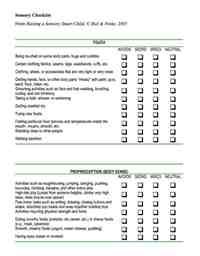What is Sensory Processing?
We all learn through our senses. Sensory processing is how we transform sensory information from within our own bodies and the external environment into messages we can act on. It’s tempting to think of senses (touch, sight, sound, movement, body awareness, taste, and smell) as separate channels of information, but they work together to give us a reliable picture of the world and our place in it.
Right now your senses are working together. You hear background sounds and feel your clothing, chair, and the floor beneath your feet. You resist gravity to stay seated. You see letters on the screen. You filter out unimportant sensory input so you can make sense of what you are reading. If you occasionally lose focus because your shirt label is itchy, you may have a mild sensory issue. If you keep sliding off your chair, look away when you hear any noise, feel like your shirt is hurting you, or the words you are reading pulsate, you may have significant sensory processing differences. Sensory differences affect all kinds of people—from those with autism, developmental delays, attention and learning difficulties, and other diagnoses to those without any other issues.
Common Signs of Sensory Processing Challenges
Out-of-proportion reactions to touch, sounds, sights, movement, tastes, or smells, including:
- Bothered by clothing fabrics, labels, tags, etc.
- Distressed by light touch or unexpected touch
- Dislikes getting messy
- Resists grooming activities
- Very sensitive to sounds (volume or frequency)
- Squints, blinks, or rubs eyes frequently
- Bothered by lights or patterns
- High activity level or very sedentary
- Unusually high or low pain threshold
Motor skill and body awareness difficulties, including:
- Fine motor delays (e.g., crayons, buttons/snaps, beading, scissors)
- Gross motor delays (e.g., walking, running, climbing stairs, catching a ball )
- Illegible handwriting
- Moves awkwardly or seems clumsy
- Low or high muscle tone
Oral motor and feeding problems, including:
- Oral hypersensitivity
- Frequent drooling or gagging
- “Picky eating”
- Speech and language delays
Poor attention and focus: often “tunes out” or “acts up”
Uncomfortable/easily overstimulated in group settings
Difficulty with self-confidence and independence

Many such behaviors are typical at certain stages of development. Many toddlers dislike fingerpaints. But a 10-year-old who has a meltdown during every art project is a different story. A strong dislike of itchy fabric or brushing teeth, shyness with strangers, or fear of a noisy goat at the petting zoo can be “typical” for a younger child as long as these sensory experiences do not interfere with day-to-day function. A child with sensory issues has responses to such experiences that are way out of proportion, consistently showing behaviors that can’t be dismissed.
Explore Your Child’s Unique Sensory Portrait
Print out this Sensory Checklist to understand your child’s unique sensory portrait. Because school presents a different set of challenges, consider asking your child’s teacher to fill it out too. If your or your child’s teacher checked off a lot of “avoids,” “seeks,” or “mixed,” get an evaluation with an occupational therapist (OT) specializing in assessing and treating sensory processing issues. Sensory Checklist in Spanish
The good news is that if your child has problems with sensory processing, there’s a lot you can do about it, especially if you work with a knowledgeable OT. As the OT enhances your child’s ability to process sensory input, you can build your own sensory smarts so your child feels more understood, while making your home, parenting approaches, and daily activities more in sync with your child’s sensory portrait.
Raising a Sensory Smart Child is filled with practical advice, real-life tips, and parenting solutions you can useimmediately to support your child at home, school, and out and about. You can find the Spanish language edition on Amazon.



Share this page: